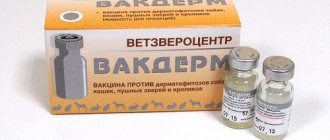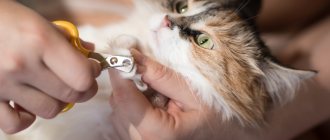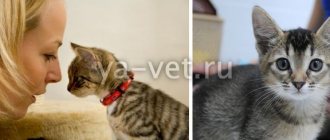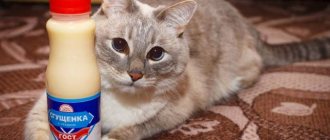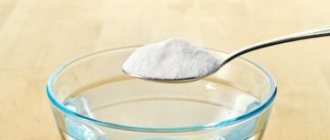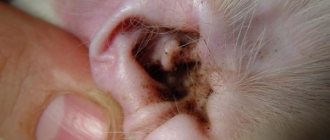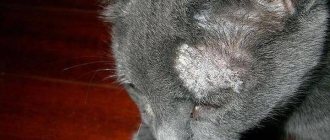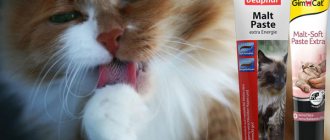What kind of oil is this and its properties
Vaseline oil is a laxative used to treat constipation in cats.
The consistency of the medicinal substance is liquid, it is absolutely colorless and odorless. Oil itself is a chemical compound obtained by refining the hydrocarbons that remain after the production of kerosene. The remaining raw material undergoes thorough filtration, so the resulting compound acquires a degree of transparency comparable to ordinary water.
Vaseline oil for cats
Sometimes petroleum jelly is called liquid paraffin, since it is its active ingredient and is used not only in medicine, but also in the food industry.
Note! Before using this product, be sure to read the instructions for using petroleum jelly for constipation in cats, otherwise the drug may not only not help, but also harm the animal.
Problems with bowel movements
Vaseline oil is a medicine for the intestines that gently activates the evacuation of intestinal contents and also effectively softens the stool. White oil—not to be confused with traditional Vaseline—is often used in humans. But cats can experience the same complaints as humans - a condition in which the animal is unable to defecate. In this case, many veterinarians recommend the use of mineral oil (vaseline) - a medicine that lubricates the walls of the digestive tract, which activates the removal of feces from the body.
But before you give your cat Vaseline oil, you need to make sure that he really suffers from constipation and not from more serious problems.
If your indoor cat spends a lot of time in the litter box:
- Pay attention to whether the cat is urinating as usual. A healthy animal usually urinates 2-3 times a day. Difficulty urinating in cats due to a bladder infection, bladder stones, or urethral obstruction are serious problems that are quite different from simple constipation. It is worth looking into the cat's litter box more often to determine how much your pet urinates per day.
- Check how much feces your cat leaves. If she spends a lot of time in the litter box, it means she may be constipated, but it could also mean she has diarrhea. With diarrhea, cats also sit in the litter box for a long time, and sometimes void in small portions, so it is a mistake to assume there is a blockage. You need to know that a healthy cat defecates approximately once a day. Your cat's stool should be firm and formed. It can often look like your cat is suffering from constipation, but there are other health problems that initially appear similar. This means that the owner needs to closely monitor their pet to make sure that it is not suffering from another problem.
- Monitor your cat for symptoms of constipation when one or more of the following signs are present:
- problems when trying to defecate;
- small, hard or dry feces;
- slimy or bloody stools;
- anorexia;
- weight loss;
- apathy;
- vomit;
- signs of abdominal pain.
These symptoms can mean a lot of things and don't just mean constipation.
If the above complaints are present, the owner must notify the treating veterinarian.
If your cat spends a lot of time in the litter box, she may be constipated.
It is necessary to consult a specialist. If the owner sees that the cat is sitting on the tray for a long time, or suspects constipation, the pet should be examined by a doctor immediately. Your veterinarian will determine whether your kitten will need medication or a diet, such as a special high-fiber cat food. Don't let your cat's constipation situation drag on for too long - this could indicate a much worse problem than just bowel retention. A cat's difficulty defecating can cause various complications, including intestinal obstruction and megacolon (an abnormal enlargement of the large intestine). If all other problems have been ruled out and the veterinarian has confirmed constipation, you should understand what it is, why constipation occurs, and what its dangers are.
Indications for the use of Vaseline oil for cats
Homemade laxative for cats
In healthy adult cats, the standard frequency of bowel movements is more than once per day. Older animals have slightly weaker peristalsis, their average frequency of trips to the toilet fluctuates within 1 time in 2 days (every other day).
Cases in which the pet does not defecate for 3 days or more are considered to be stool retention, or constipation.
Usually the cause of this disease is an unbalanced diet - a small amount of fluid and fiber. This diet provokes the accumulation of feces, which gets stuck in the intestines and cannot be released into the external environment. The way out of this situation is to use liquid petroleum jelly, which restores the processes of removing solid feces.
When a cat's stomach begins to hurt due to difficulty defecating, its behavior changes, so an attentive owner will immediately notice signs of illness. Approaching the tray, the animal will begin to strain intensely, raise and lower its tail, but nothing happens.
The cat may start digging for the litter, purring, and as a result will get rid of just a few dry balls. With prolonged constipation, the pet will walk around the tray with a plaintive meow and attract the owner’s attention. In this case, you can’t do without Vaseline oil.
Bimin
For cats and dogs, the drug Bimin is produced based on petroleum jelly. It is prescribed both for therapeutic purposes, to normalize stool, and for preventive purposes.
The drug is an oily liquid without color, odor or taste. The product gives a mild laxative effect:
- softens feces and promotes their evacuation;
- removes balls of hair (trichobezoars).
- normalizes the functioning of the gastrointestinal tract.
Taking Bimin does not cause discomfort or pain in animals. The composition contains only natural ingredients. Bimin does not cause allergies and does not penetrate into the bloodstream.
The instructions recommend giving the drug to the animal once in the morning. Dosage – 1 ml per 1 kg of weight. When using the product in accordance with the instructions, no side effects are detected. Even if the dose is accidentally exceeded by 3 times, there will be no danger to the cat’s health.
What are the properties of this drug
Flea drops for cats: remedy, tablets
Vaseline oil is considered an absolutely safe medicine for cats, since it is not absorbed into the walls of internal organs, but leaves the body in full along with waste.
Properties of Vaseline Oil
The oil has unique properties that make it an effective remedy in the fight against constipation. It promotes the slipping of waste from the intestinal tract. In addition, the drug is very gentle on the intestines, prevents injuries to internal organs, gently liquefying hardened stool.
For reference: the oil has a much milder effect than special laxatives.
Operating principle and methods of use
Flea collar for cats and ticks: how it works
After consuming the oil, the intestines become covered with a slippery film, as a result of which its motility increases. The drug acts on the digestive organ in such a way that hardened feces begin to leave the pet’s body naturally.
Thanks to a kind of barrier formed under the influence of oil, waste products do not come into contact with the walls of the rectum. Toxins and water from food bolus are no longer absorbed. The medicinal substance does not enter the bloodstream, and therefore does not provoke allergic reactions.
There is a slow movement of feces and hairballs, and after some time the digestive tract is cleared of them. The mild laxative effect of Vaseline oil normalizes the animal's stool.
Vaseline oil should be administered to the animal on an empty stomach, preferably in the morning. To ensure that the drug gets inside, the owner should involve an assistant in the procedure. The product, previously drawn up in a thin disposable syringe (without a needle), is injected into the animal’s oral cavity.
Before the procedure, the cat should be calmed; simple stroking will be enough. When the pet is ready, the assistant will need to fix the cat's head in his hands and open his jaw so that the resulting side gap between the teeth is large enough for the syringe.
The liquid must be injected onto the root of the tongue, since only in this case the animal will have to swallow it and not spit it out. The procedure should be fairly quick, and you should not stop stroking the cat.
Products for removing hair from a cat's stomach
- That's another thing. Now I’m going to get a second cow...
- How to wash?
- We need to get less dirty! And in general, some people wash themselves with their tongue.
Cats are exceptionally neat and keep their coats clean without outside help. According to scientists, up to 30% of a cat's life is spent licking fur. During this hygienic procedure, the cat swallows some of the hairs, since these animals are physiologically unable to spit out.
Normally, hairs pass through the digestive tract and are excreted from the body in feces. But if there are too many hairs, they accumulate in the stomach, forming a lump. Sometimes owners see an animal burping on its own - such vomiting is not a pathology or a cause for concern; on the contrary, it brings relief to the animal.
But sometimes the digestive tract of a domestic cat, whose ancestors have lived next to humans for hundreds of years and fed on processed food, cannot cope with increased stress.
Particularly often, representatives of long-haired breeds suffer from problems with removing hairs that have entered the gastrointestinal tract. Also at risk are old and weakened cats, sedentary cats, those suffering from obesity, and metabolic diseases. During the period of rapid molting, problems can arise in completely healthy individuals. Therefore, every owner should know how to remove hair from a cat’s stomach.
Dosage of the drug
The dosage of petroleum jelly should be calculated based on the method of administration, age and weight of the animal. Typically, the instructions accompanying the drug indicate the following numbers:
- For preventive purposes, 0.5 ml of oil per kg of weight should be administered.
- During the treatment period - 1 ml per kg of weight.
Within 3-4 hours after the manipulations, the cat will most likely successfully go to the toilet, but if this does not happen, then it will be necessary to re-introduce the oil (5-6 g), and after 1 hour repeat the procedure again (in the same dosage ).
In total, the number of procedures should not be more than five, and the maximum permissible daily dose for an adult cat is 20 ml. If there is no reaction of the animal’s body to the drug, it is necessary to urgently seek veterinary help.
Important! It is necessary to follow the rules for using the oil, otherwise the drug will either not cope with the problem or will cause additional disruptions to the gastrointestinal tract.
In case of prolonged constipation, the cat can be given an enema. To carry it out, you will need an assistant who will hold the pet during the administration of the drug.
- You need to purchase a syringe from a veterinary pharmacy. Add up to 10 ml (if the animal is light in weight, you should add about 5 ml) of oil. The drug can be used either in its pure form or half diluted with water and heated to a temperature of 36°C.
- Lubricate the tip of the enema (lubricant is perfect for this) and smoothly move it into the lumen of the rectum 1.5 cm.
- If the animal’s body does not react during the first 10 minutes after the procedure, it is necessary to repeat the manipulation again after 3 hours at the same dosage.
- If the second microenema also does not help, then you need to seek veterinary help. Most likely, the animal's intestines are already clogged with fecal stones and surgery will probably be required to remove them.
Preventing constipation
Constipation is an unpleasant condition that is accompanied by painful symptoms. Not a single animal is safe from it, especially if simple preventive measures are not followed.
Difficulty defecating can be prevented if the cat owner follows the following recommendations:
Proper nutrition and drinking regime. The animal's diet should be enriched with healthy foods high in vitamins and minerals. If your cat eats only dry food, you need to make sure that he drinks enough water per day - at least 250 ml. Lack of fluid is one of the main causes of constipation.
Do not mix natural products with industrial dry or wet food. Take specialized vitamin and mineral complexes.
You should not give too cold, frozen food, which negatively affects the process of food digestion and intestinal peristalsis, slowing it down. The optimal food temperature is +20…+30 °C. You should not give your animal food that is too hot.
Timely prevent worms using anthelmintic drugs. Often, damage to the digestive system by worms leads to the development of permanent constipation. The diet should regularly include dairy and fermented milk products, herbs, and vegetables, which have a beneficial effect on the functioning of the gastrointestinal tract.
The main preventive measure is to monitor your pet’s health. Many diseases in cats do not manifest themselves for a long time. The only sign of cancer or urolithiasis is regular constipation.
Treatment of kittens
Kittens are treated according to the same principle as adult animals.
Only the dosage of the drug will differ. For kittens (up to 1 kg), it will be enough to drop the product on the withers at the rate of 1-3 drops. It is not recommended to administer additional doses to children. It is strictly forbidden to exceed dosages.
Treatment of kittens
The laxative may not work if the discomfort is caused by volvulus or obstruction. Pathologies of this kind are treated through surgery, and during the recovery period, drugs of a different type are prescribed.
In any case, if none of the methods is effective, you need to contact a veterinarian. In some cases, individual reactions of the body to petrolatum oil may be observed, so standard methods of its use do not work.
Constipation in a cat: treatment at home
Constipation in a cat is a dangerous disease. Stagnation of feces provokes the development of chronic diseases, obstruction, and intoxication. Treatment at home can be done in the early stages of constipation.
When the absence of stool continues for more than three days, it is better to take the cat to the veterinarian.
How to correctly distinguish the onset of constipation in a cat and the usual condition? You will need to know the number of daily trips to the litter box.
Normally, a healthy domestic cat uses the litter box 1-2 times a day. The number of approaches depends on the type of feeding: natural products take longer to digest than prepared ones.
Kittens, due to their age and fast metabolism, poop several times. Older animals may have one bowel movement every two to three days.
The second important point in clarifying the presence of intestinal problems is the analysis of the appearance of stool: color, consistency, smell.
The Bristol scale will help you assess the degree of consistency : the figure shows options for the appearance of stool. The optimal picture is number four – soft oblong stool. The color of the discharge depends on the composition of the feed, usually ranging from brown to dark gray. The smell is specific, not unpleasant.
The first signal of possible problems, the occurrence of stool, is some dryness of the stool. Periodic bowel movements in uneven piles and unformed pieces are also alarming. Veterinarians distinguish two types of constipation: temporary, when part of the feces comes out, and obstruction - the feces harden inside the intestines.
Causes of constipation in cats
The phenomenon of constipation is often observed in older cats; due to age, the natural peristalsis of the intestines weakens, feces move more slowly, heavy food takes longer to digest, and processed food has time to be severely dehydrated before excretion. In young cats, a similar situation can occur after anesthesia. Narcotic sleep helps to relax many muscles; the intestines are almost the last to return to normal functioning.
Therefore, after sterilizing a cat, it is so important to follow the correct diet: give porridge, put less strain on the digestive system. In general, any surgical intervention can lead to constipation.
The intestine is a long, convoluted tube containing many rings. Perforation of the abdominal wall and actions with a scalpel leave microdamages, promoting the formation of adhesions and gluing of individual sections of the intestinal walls.
An excessively curved area causes natural inhibition of feces.
Usually the presence of adhesions can be diagnosed with an x-ray; in any case, home treatment is not expected; the situation can only be corrected by surgery. Adhesions are a serious problem, but luckily they are quite rare.
By the way, using cleansing enemas for this type of ailment is strictly prohibited; it can further injure the digestive system.
For several days after the operation, carefully monitor the cat’s condition; any problems of an excretory nature should be immediately brought to the attention of a veterinarian.
Any diseases of the nervous system that reduce the innervation of the intestines cause constipation. Mechanical damage, injuries, ingestion of toys and wool are also very dangerous. Inflammatory processes occurring inside the intestines become a real problem. Constipation becomes a symptom of illness.
A common cause of constipation is improper feeding. Giving exclusively dry food causes intensive pumping of water from processed food, and too dry feces get stuck. Insufficient fluid intake is a great source of problems.
The cat should always have free access to clean, drinking water.
A recumbent lifestyle and lack of mobility changes the structure of the animal’s body, causing excess weight to appear, which definitely negatively affects the cat’s well-being. The problem of excess weight is very relevant for neutered cats. Failure to comply with the basic rules of feeding such cats naturally leads to the occurrence of digestive disorders.
Many diseases, especially diabetes , lead to the development of constipation. Separately, it is worth dwelling on damage by internal parasites. Helminths that settle inside the gastrointestinal tract pose a serious danger. In addition to exposure to waste products, destruction of intestinal walls, the bodies of parasites ideally clog the intestinal lumen.
Severe helminthic infestation is manifested by a whole host of symptoms, in addition to constipation, so it is important to timely monitor changes in the behavior and condition of the domestic cat. A careful assessment of the composition of feces will help to notice the presence of worms, eggs, and larvae.
An ambiguous cause of constipation is the formation of woolen blockages around the anus. Typical for long-haired cat breeds. Uncombed wool tends to fall into tangles. A large amount of curled hair prevents the natural passage of feces.
Usually a strong odor alerts the owner to the accumulation of secretions near the tail.
Symptoms of constipation in a cat
Another important note is that some cats do not tolerate a dirty litter box. Therefore, before suspecting a disease, you should carefully inspect the apartment.
Contraindications for use
Before starting a treatment course, you must consult a veterinarian. It is important that a specialist examines the animal, conducts a number of necessary tests and determines contraindications for treatment with petroleum jelly.
For example, it is prohibited to use the product if the illness is caused by the presence of solid objects in the intestines or in the case of a tumor. In such situations, the animal is usually put under emergency surgery, with which the use of laxatives is in no way compatible, since they can provoke the formation of fistulas, which pose an immediate threat to the pet’s life.
In addition, the cat is prohibited from administering Vaseline oil:
- for intestinal ulcers;
- with intestinal bleeding of unknown etiology;
- with complicated hemorrhoids in the last stages.
Laxatives are not recommended for use in osteoporosis and rickets. They can interfere with the absorption of medications taken and thereby provoke complications of these diseases. This drug is also prohibited during pregnancy and while feeding cats, as well as in cases of allergies to Vaseline and inflammation of the stomach.
Important! The use of Vaseline oil or other laxatives for constipation after sterilization is strictly prohibited, as this can lead to the death of the pet.
How to give
Oil for the treatment of constipation in cats should not be mixed with anything. Use only pure natural product purchased at the pharmacy.
Algorithm of actions for oral administration:
- draw the required amount of oil into a syringe without a needle;
sit the pet on your lap (sideways or backwards);- holding the cat's head with one hand, place the syringe on the side between the teeth and cheek with the other, towards the root of the tongue;
- lifting the animal's head up, slowly introduce oil.
Everything needs to be done carefully, without haste, so that the pet does not choke. Otherwise, during the next session, the cat will resist, which will complicate the administration of the product.
Some people mix oil with food and wait for the cat to eat it. But if your pet is constipated, he usually loses his appetite. Until the animal has emptied its intestines, it is unlikely to touch the food.
Side effects
Side effects are quite rare in cats. This usually happens due to failure to follow the instructions provided with the drug. In case of abuse, exceeding the permissible concentration, or non-compliance with application regimens, the following side effects may occur:
- formation of nodes in the intestines;
- spontaneous release of oily feces;
- dehydration;
- lack of fat-soluble vitamins.
In some cases, dehydration occurs when using Vaseline oil.
The owner must carefully monitor the behavior and well-being of his pet after medicinal procedures. If your cat is vomiting, refuses to eat, or becomes less active, you should consult a doctor. Also, drug intolerance should not be ruled out.
When does a cat need a laxative?
Cats should be given a laxative only after the cause of their difficulty in defecation has been determined. Constipation can be caused by poor nutrition, stress, moving, or fear. Cats sometimes experience constipation caused by emotional and psychological factors. For example, constipation may occur due to rejection of the tray, filler, new house, or simply due to the appearance of a new pet in the house.
It is necessary to find out the specific reason, try to create comfortable conditions for the pet to go to the toilet, change the litter, use anti-stress sedatives prescribed by the veterinarian. Constipation, which is caused by a change in food, the introduction of a new product into the diet, or a transition to a different type of food, begins to be treated with the use of a special diet or switching to dietary nutrition.
Constipation can also occur with:
- eating diet foods with low protein content;
- the presence of a tumor in the digestive tract;
- dehydration of the body;
- inflammatory processes in the rectum;
- orthopedic problems, when the pet finds it difficult to sit down and defecate comfortably;
- sedentary lifestyle;
- presence of megacolon disease;
- renal failure;
- helminthiasis;
- the presence of hairballs in the stomach;
- the presence of growths, inflammation on the body.
Constipation in a cat is detected by the absence of defecation for more than 2-3 days. At the same time, the cat meows, makes unsuccessful attempts to sit in the tray or simply in a hidden corner, wanting to free itself from uncomfortable feelings.
The cat may constantly visit the toilet and defecate with great difficulty. The feces have the form of dense nuts or a watery appearance. These symptoms indicate the presence of chronic constipation.
Both acute and chronic constipation is accompanied by weakness, lack of appetite in the animal, nausea and vomiting (rarely). A cat may refuse to eat and lose weight, some stop licking themselves, and their nose is completely dry.
Laxatives for cats should only be used after consultation with a veterinarian. Constipation can be confused with intestinal obstruction, and this pathology must be treated in a different way, using other medications.
The drugs are mainly used for cats after sterilization/castration, or when the animal has not had bowel movements for more than three days.
Laxatives should not be used if constipation is caused by swallowing hard objects or bones, or if there are traces of mucus or blood in the stool.
How can you replace Vaseline oil?
After completing a course of treatment using petroleum jelly, you must either stop taking this drug or replace it with another.
Typically, in such cases, cat owners use:
- Duphalac,
- Microlax,
- Lactusin.
In case of mild constipation, it is allowed to switch to treatment with traditional methods. You can also give your domestic cat vegetable oil or fish oil (a couple of drops). This will allow the animal to feel much easier during bowel movements, since the feces will be liquefied and leave the body much faster and softer.



